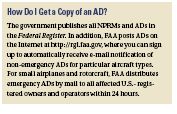The ABCs of ADs
Tausif Butt and David Hirt
Reprinted with permission from FAA Aviation News
Your mechanic calls. He has found a crack in your airplane’s wing spar. Your first thought: “What is it going to cost?” His second comment, though, takes your thoughts from money to safety. He tells you that yours is the third aircraft he has found with the same crack in the spar, and one of them was near total failure. Now what?
With this kind of pattern, your mechanic will want to contact an aviation safety inspector (ASI) at the local FAA Flight Standards District Office (FSDO) and report the concern. (Contact information for the appropriate FSDO is available via Internet at www.faa.gov/about/office_org/field_offices/fsdo.) Your mechanic should also submit a malfunction and defect report through FAA. These reports alert other owners and maintenance personnel of the safety issue.
After your mechanic contacts FAA, the ASI will coordinate with the appropriate FAA engineer to evaluate the safety issue. The engineer will typically analyze the design details and the nature of the reported failure, research related service history, talk with the type certificate holder, and coordinate with other FAA engineers, specialists, and managers. The engineer’s evaluation includes conducting a risk assessment, considering items such as the safety impact of the reported condition, the type of aircraft involved, how the majority of those aircraft are used, and how often the condition has occurred in other aircraft of the same or similar type design. Based on this evaluation, the FAA will determine whether there is an unsafe condition that warrants issuing an airworthiness directive (AD).
Once FAA determines that mandatory corrective action is necessary, the agency develops an AD that calls for appropriate actions and sets out timeframes for completing those actions. FAA strives to develop Ads that correct the unsafe condition without creating an undue burden for aircraft owners, operators, and pilots. Some safety issues require immediate correction, that is, repairs must be made before the aircraft flies again. Wherever appropriate, though, FAA develops actions and compliance times that allow for the required work and as little impact to your flying as the situation allows. Yet, there is simply no way to avoid the reality that Ads will affect both your flying schedule and checkbook. FAA works hard to develop corrective actions that address the unsafe condition without requiring more action than necessary.
FAA also tries to write ADs in a way that makes the required action clear and completely understandable to those responsible for the work. This requires consulting pilots, maintenance specialists, technical writers, engineers, legal counsel, and others during development of the AD. FAA also works with the appropriate industry groups to ensure the availability of any parts, tools, or service instructions necessary to comply with the AD.
Different Types of ADs
The nature of the unsafe condition and the urgency required to correct it determine the type of AD action that FAA takes. Normally, the agency issues a notice of proposed rulemaking (NPRM) followed by a final rule. NPRMs request public comments on the proposed action. After the comment period closes, FAA issues the final rule, taking into account all comments received.
In certain cases, the critical nature of an unsafe condition and the need for timely corrective action may require issuing an AD in final rule form without first issuing an NPRM and allowing time for public comment. In these cases, the agency still provides an opportunity for public comment after AD issuance, and it may change the AD as a result of comments received.
FAA issues an emergency AD when an unsafe condition exists that requires immediate corrective action. The intent of an emergency AD is to rapidly correct an immediate safety of flight situation.
FAA recognizes that you may have information or ideas that had not been considered when developing an NPRM or an AD without a prior NPRM. FAA values the public’s input on these proposed or mandated actions and has used input in the past to change compliance times, inspection or maintenance actions, and other items from what was originally proposed or mandated. FAA encourages you to send any ideas or comments you may have about proposed or mandated actions, along with supporting data. Each NPRM or final rule (without prior NPRM) contains details on how to comment.
Many airplane type clubs monitor the Federal Register and inform their members when an NPRM or final rule affecting their aircraft type has been issued.
Once an AD affecting your aircraft takes effect, by regulation you can operate the aircraft only if it meets the requirements of the AD. Unless the condition is an immediate safety of flight concern, the AD will allow you to continue operating the aircraft for a specified amount of time before you must carry out the required actions.
Alternative Ways to Comply
If your mechanic has a better way to address the unsafe condition cited in an AD, FAA does allow alternative methods to comply with an AD’s requirements. If you want to propose a different method or compliance time to address the safety issue, you can apply for an alternative method of compliance (AMOC). Submit the proposal through your principal inspector or local FSDO to the Aircraft Certification Office (ACO), which reviews and issues approval or denial. Include the specific actions you are proposing to address the unsafe condition, along with substantiating data. FAA will review your request and determine if the proposal addresses the unsafe condition.
Tausif Butt and David Hirt are aerospace engineers at FAA’s Small Airplane Directorate in Kansas City, Missouri.

|